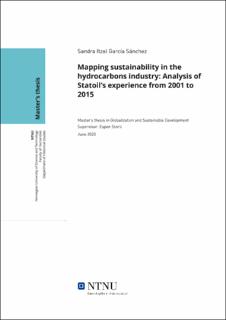| dc.description.abstract | Historians have analyzed the linkages between hydrocarbons corporations and sustainability. Some of
them argue that oil and gas operations destroy ecosystems while others claim that businesses can improve
financial development, job creation, and social investments. The year 1987 define a dividing line into the
global perceptions of sustainable development, while the new millennium brought a transformation into the
reporting of sustainability by oil and gas industries.
The historical and qualitative methodology implemented was chosen to address the main research question
of ¿How did Statoil embrace sustainability into its guidelines, operations, and reporting system from 2001 to
2015? Two methodologies were used, first the construction of a historical case of study based on the Statoil´s
annual and sustainability report evolution from 2001 to 2015. The second and core method used was an
adaptation of the Global Compact Self-Assessment Tool (GCSAT) of the United Nations Global Compact “
UNGC” into a historical matrix and mapping of sustainability, which allowed the analysis of the reports in
comparison with the economic, social, political and environmental pillars of the sustainable development but
also the response of the company to sustainability benchmarks such as Global Reporting Initiative “GRI”,
Carbon Disclosure Project “CDP” and the 10 principles of the UNGC.
The analysis results reveal that external historical factors such as the oil crisis of 2004, the entered into
the force of the Kyoto Protocol in 2005, the economic crisis of 2008, the implementation of the Paris Agreement in 2015 and terrorist attacks, transformed the Statoil´s sustainability reporting system and guidelines as much as the structural changes after the merger with Hydro in 2007 and the separation of Statoil fuel & Retail in 2010 did. While on the other hand the biggest sustainability challenges were experienced in terms of corruption, Green House Gas emissions, and harmful chemical discharges. However, the company found a way to ensure its sustainability through human capital investments, technological improvements, renewable energy, low carbon policies, key business, and partnerships.
Key Words: Sustainability, Kyoto Protocol, Statoil, Sustainable Development, Oil and Gas, UNGC, GRI,
CDP, CSR, Sustainable Development Goals, Millennium Development Goals | |
